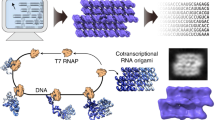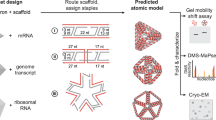Abstract
Natural biomolecular assemblies such as molecular motors, enzymes, viruses and subcellular structures often form by self-limiting hierarchical oligomerization of multiple subunits1,2,3. Large structures can also assemble efficiently from a few components by combining hierarchical assembly and symmetry, a strategy exemplified by viral capsids4. De novo protein design5,6,7,8,9 and RNA10,11 and DNA nanotechnology12,13,14 aim to mimic these capabilities, but the bottom-up construction of artificial structures with the dimensions and complexity of viruses and other subcellular components remains challenging. Here we show that natural assembly principles can be combined with the methods of DNA origami15,16,17,18,19,20,21,22,23,24 to produce gigadalton-scale structures with controlled sizes. DNA sequence information is used to encode the shapes of individual DNA origami building blocks, and the geometry and details of the interactions between these building blocks then control their copy numbers, positions and orientations within higher-order assemblies. We illustrate this strategy by creating planar rings of up to 350 nanometres in diameter and with atomic masses of up to 330 megadaltons, micrometre-long, thick tubes commensurate in size to some bacilli, and three-dimensional polyhedral assemblies with sizes of up to 1.2 gigadaltons and 450 nanometres in diameter. We achieve efficient assembly, with yields of up to 90 per cent, by using building blocks with validated structure and sufficient rigidity, and an accurate design with interaction motifs that ensure that hierarchical assembly is self-limiting and able to proceed in equilibrium to allow for error correction. We expect that our method, which enables the self-assembly of structures with sizes approaching that of viruses and cellular organelles, can readily be used to create a range of other complex structures with well defined sizes, by exploiting the modularity and high degree of addressability of the DNA origami building blocks used.
This is a preview of subscription content, access via your institution
Access options
Access Nature and 54 other Nature Portfolio journals
Get Nature+, our best-value online-access subscription
$29.99 / 30 days
cancel any time
Subscribe to this journal
Receive 51 print issues and online access
$199.00 per year
only $3.90 per issue
Buy this article
- Purchase on Springer Link
- Instant access to full article PDF
Prices may be subject to local taxes which are calculated during checkout





Similar content being viewed by others
References
Stock, D., Leslie, A. G. & Walker, J. E. Molecular architecture of the rotary motor in ATP synthase. Science 286, 1700–1705 (1999)
Booy, F. P. et al. Finding a needle in a haystack: detection of a small protein (the 12-kDa VP26) in a large complex (the 200-MDa capsid of herpes simplex virus). Proc. Natl Acad. Sci. USA 91, 5652–5656 (1994)
Ban, N. & McPherson, A. The structure of satellite panicum mosaic virus at 1.9 Å resolution. Nat. Struct. Biol. 2, 882–890 (1995)
Caspar, D. L. & Klug, A. Physical principles in the construction of regular viruses. Cold Spring Harb. Symp. Quant. Biol. 27, 1–24 (1962)
King, N. P. et al. Accurate design of co-assembling multi-component protein nanomaterials. Nature 510, 103–108 (2014)
Lai, Y. T. et al. Structure of a designed protein cage that self-assembles into a highly porous cube. Nat. Chem. 6, 1065–1071 (2014)
Lanci, C. J. et al. Computational design of a protein crystal. Proc. Natl Acad. Sci. USA 109, 7304–7309 (2012)
Thomson, A. R. et al. Computational design of water-soluble α-helical barrels. Science 346, 485–488 (2014)
Bale, J. B. et al. Accurate design of megadalton-scale two-component icosahedral protein complexes. Science 353, 389–394 (2016)
Geary, C., Rothemund, P. W. & Andersen, E. S. A single-stranded architecture for cotranscriptional folding of RNA nanostructures. Science 345, 799–804 (2014)
Guo, P. The emerging field of RNA nanotechnology. Nat. Nanotechnol. 5, 833–842 (2010)
Jones, M. R., Seeman, N. C. & Mirkin, C. A. Programmable materials and the nature of the DNA bond. Science 347, 1260901 (2015)
Tian, C. et al. Directed self-assembly of DNA tiles into complex nanocages. Angew. Chem. Int. Ed. 53, 8041–8044 (2014)
Wei, B., Dai, M. & Yin, P. Complex shapes self-assembled from single-stranded DNA tiles. Nature 485, 623–626 (2012)
Rothemund, P. W. Folding DNA to create nanoscale shapes and patterns. Nature 440, 297–302 (2006)
Douglas, S. M. et al. Self-assembly of DNA into nanoscale three-dimensional shapes. Nature 459, 414–418 (2009)
Veneziano, R. et al. Designer nanoscale DNA assemblies programmed from the top down. Science 352, 1534 (2016)
Benson, E. et al. DNA rendering of polyhedral meshes at the nanoscale. Nature 523, 441–444 (2015)
Bai, X. C., Martin, T. G., Scheres, S. H. & Dietz, H. Cryo-EM structure of a 3D DNA-origami object. Proc. Natl Acad. Sci. USA 109, 20012–20017 (2012)
Funke, J. J. & Dietz, H. Placing molecules with Bohr radius resolution using DNA origami. Nat. Nanotechnol. 11, 47–52 (2016)
Iinuma, R. et al. Polyhedra self-assembled from DNA tripods and characterized with 3D DNA-PAINT. Science 344, 65–69 (2014)
Gerling, T., Wagenbauer, K. F., Neuner, A. M. & Dietz, H. Dynamic DNA devices and assemblies formed by shape-complementary, non-base pairing 3D components. Science 347, 1446–1452 (2015)
Douglas, S. M. et al. Rapid prototyping of 3D DNA-origami shapes with caDNAno. Nucleic Acids Res. 37, 5001–5006 (2009)
Wagenbauer, K. F. et al. How we make DNA origami. ChemBioChem 18, 1873–1885 (2017)
Furini, S., Domene, C., Rossi, M., Tartagni, M. & Cavalcanti, S. Model-based prediction of the α-hemolysin structure in the hexameric state. Biophys. J. 95, 2265–2274 (2008)
Konijnenberg, A. et al. Top-down mass spectrometry of intact membrane protein complexes reveals oligomeric state and sequence information in a single experiment. Protein Sci. 24, 1292–1300 (2015)
Leung, C. et al. Stepwise visualization of membrane pore formation by suilysin, a bacterial cholesterol-dependent cytolysin. eLife 3, e04247 (2014)
Perlmutter, J. D. & Hagan, M. F. Mechanisms of virus assembly. Annu. Rev. Phys. Chem. 66, 217–239 (2015)
Dietz, H., Douglas, S. M. & Shih, W. M. Folding DNA into twisted and curved nanoscale shapes. Science 325, 725–730 (2009)
Su, T. et al. The force-sensing peptide VemP employs extreme compaction and secondary structure formation to induce ribosomal stalling. eLife 6, e25642 (2017)
Acknowledgements
We thank A. Neuner and V. Hechtl for technical help, M. Kube and J. Funke for computational assistance, D. van Sinten and S. Welsch from FEI for their support with the Titan Krios, F. Praetorius and B. Kick for scaffold preparation, S. Fraden for discussions, and S. Barth for collecting auxiliary data. We also thank A. Holleitner and M. Altschner for access to the helium-ion microscope. This work was supported by a European Research Council Starting Grant to H.D. (grant agreement number 256270) and the Deutsche Forschungsgemeinschaft through grants provided within the Gottfried-Wilhelm-Leibniz Program, the Excellence Clusters CIPSM (Center for Integrated Protein Science Munich), NIM (Nanosystems Initiative Munich) and the Technische Universität München (TUM) Institute for Advanced Study. K.F.W. and H.D. are grateful for additional support from the Bosch Forschungsstiftung.
Author information
Authors and Affiliations
Contributions
K.F.W. and C.S. performed research, H.D. designed the research. K.F.W. and H.D. wrote the manuscript. All authors analysed and discussed data and commented on the manuscript.
Corresponding author
Ethics declarations
Competing interests
The authors declare no competing financial interests.
Additional information
Reviewer Information Nature thanks M. Kostiainen, T. LaBean and H. Yan for their contribution to the peer review of this work.
Publisher's note: Springer Nature remains neutral with regard to jurisdictional claims in published maps and institutional affiliations.
Supplementary information
Supplementary Information
This file contains Supplementary Materials and Methods, Supplementary Figures 1-35, Supplementary Notes 1-3 and Supplementary references. (PDF 32136 kb)
Tomogram of the tetrahedron object
Top: cryo-EM micrographs acquired from different tilt angles of the sample goniometer. Bottom: slices through the tomogram. (MOV 6740 kb)
Tomogram of the hexahedron object
Top: cryo-EM micrographs acquired from different tilt angles of the sample goniometer. Bottom: slices through the tomogram. (MOV 7166 kb)
Tomogram of the dodecahedron object
Top: negative-stained micrographs acquired from different tilt angles of the sample goniometer. Bottom: slices through the tomogram. (MOV 5656 kb)
Rights and permissions
About this article
Cite this article
Wagenbauer, K., Sigl, C. & Dietz, H. Gigadalton-scale shape-programmable DNA assemblies. Nature 552, 78–83 (2017). https://doi.org/10.1038/nature24651
Received:
Accepted:
Published:
Issue Date:
DOI: https://doi.org/10.1038/nature24651
This article is cited by
-
Prediction of DNA origami shape using graph neural network
Nature Materials (2024)
-
Blueprinting extendable nanomaterials with standardized protein blocks
Nature (2024)
-
Harnessing a paper-folding mechanism for reconfigurable DNA origami
Nature (2023)
-
The harmony of form and function in DNA nanotechnology
Nature Nanotechnology (2023)
-
Isothermal self-assembly of multicomponent and evolutive DNA nanostructures
Nature Nanotechnology (2023)
Comments
By submitting a comment you agree to abide by our Terms and Community Guidelines. If you find something abusive or that does not comply with our terms or guidelines please flag it as inappropriate.



